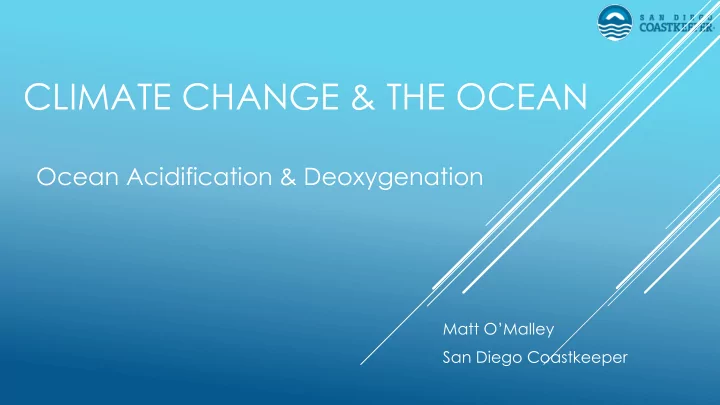

CLIMATE CHANGE & THE OCEAN Ocean Acidification & Deoxygenation Matt O’Malley San Diego Coastkeeper
The ocean acts as a carbon “sink”, absorbing up to 30% of the CO2 released into the atmosphere. As CO2 levels rise, so do the levels in the ocean. This uptake helps buffer terrestrial heating but also causes the pH levels in the ocean to lower, causing ocean acidification. Warming waters cause also deoxygenation and hypoxia. Urban and Ag discharges lead to further acidification.
“Ocean warming and acidification, loss of oxygen, and changes in nutrient supplies are already affecting the distribution and abundance of marine life in coastal areas, in the open ocean, and at the sea floor”. -Sept 2019 IPCC report
OA binds up carbonate ions and makes them less abundant – ions that corals, oysters, mussels, and other shelled organisms need to build shells and skeletons.
WHAT’S CA DOING ABOUT IT?
CALIFORNIA’S OA PLAN Adopted Oct 2018, a 10-year vision for addressing OA and pragmatic actions towards that goal Lays out strategies and actions to: identify and prepare for risks/impacts reduce causes of OA improve resilience of vulnerable groups minimize harmful effects
CALIFORNIA’S OA PLAN Conduct statewide vulnerability assessment Target investments in monitoring to inform decisions Integrate OA into state policies, planning, operations Reduce pollution that exacerbates OA Restore and enhance seagrass meadows, kelp forests, and salt marshes Evaluate shellfish aquaculture and fisheries approaches that can help
SOCAL’S ROLE SCCWRP modeling project to determine impact of local, non- atmospheric sources
INITIAL STUDY FINDINGS “Land -based sources of nutrients can have a measurable effect on seawater chemistry in nearshore waters”, leading to acidification and hypoxia In the Southern California Bight, land-based nutrients are being introduced mainly via discharges of treated wastewater effluent through ocean outfalls These hot spots are persistent, & don’t just disperse into the surrounding waters, and directly impact the marine communities around outfalls
PART OF THE SOLUTION (REGULATORY) CA Coastkeeper Alliance advocating for OA water quality objective based on this study. Study is not yet finalized, but data shows anthropogenic discharges associated with acidification and hypoxia State Water Board has committed to develop OA WQO once study is finalized and “science is ready”.
PART OF THE SOLUTION (REGULATORY) CCKA, NRDC, and others advocating for elimination of 95% of ocean wastewater discharges by 2040 Advocating for WWTP to incorporated denitrification into their treatment
PART OF THE SOLUTION (NATURE-BASED) Coastal wetlands, kelp, eelgrass, salt marsh restoration and protection serves to sequester CO2 stabilize and filter nutrients and organic carbon These areas serve as critical nursery habitat for fish species and provide additional ecosystem services Advocating for a Coastal Wetland Policy that creates a net gain of ecologically functioning wetlands
Matt O’Malley, ED & Managing Attorney matt@sdcoastkeeper.org www.sdcoastkeeper.org www.cacoastkeeper.org
Recommend
More recommend